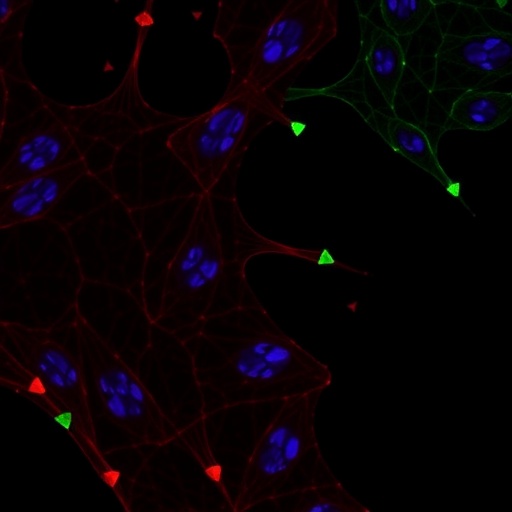In the quest to unravel the molecular intricacies underpinning reproductive biology, a groundbreaking study has recently illuminated the crucial role of DCAF13 in uterine function and fertility. Published in Cell Death Discovery, this pioneering research elucidates how the disruption of DCAF13 impairs uterine physiology, thereby elucidating novel pathways that govern fertility. As infertility continues to challenge healthcare worldwide, insights into key molecular players like DCAF13 open new avenues for therapeutic strategies aimed at restoring reproductive capability. This comprehensive analysis reveals how DCAF13 functions at the molecular level, offering a glimpse into the complex orchestration of uterine environment regulation.
The study employs cutting-edge genetic and molecular biology techniques to investigate the uterine-specific functions of DCAF13, a member of the DDB1- and CUL4-associated factors family. Prior work has hinted at the diverse roles of DCAF proteins in cellular processes; however, this is one of the first investigations to directly link DCAF13 to reproductive biology. Researchers utilized a conditional knockout mouse model to selectively ablate DCAF13 expression in uterine tissue, revealing profound effects on fertility outcomes. The findings suggest that DCAF13 is indispensable for maintaining uterine homeostasis, pivotal for embryo implantation, and successful pregnancy progression.
At a mechanistic level, DCAF13 is posited to act as an adaptor for E3 ubiquitin ligases, aiding in substrate specificity for protein ubiquitination and degradation. This regulatory function is critical; by controlling the turnover of specific proteins, DCAF13 ensures that uterine cells respond appropriately to hormonal cues and physiological demands. The absence of DCAF13 disturbs the delicate balance of protein dynamics, leading to an altered uterine microenvironment that compromises embryo implantation and fertility. Such fine-tuned molecular regulation spotlights the importance of the ubiquitin-proteasome system in reproductive health.
.adsslot_m94aFI3pGJ{width:728px !important;height:90px !important;}
@media(max-width:1199px){ .adsslot_m94aFI3pGJ{width:468px !important;height:60px !important;}
}
@media(max-width:767px){ .adsslot_m94aFI3pGJ{width:320px !important;height:50px !important;}
}
ADVERTISEMENT
Histological analyses presented in the study reveal substantial morphological defects in uteri lacking DCAF13. Compared to wild-type controls, mutant uteri exhibit disrupted epithelial architecture and impaired stromal differentiation. These alterations likely contribute to the observed fertility deficits, underscoring the integral relationship between uterine tissue integrity and reproductive success. The authors emphasize that these structural anomalies are reflective of underlying molecular perturbations, including dysregulated gene expression and aberrant signaling pathways.
Exploring molecular signaling cascades, the research indicates that DCAF13 influences key pathways related to cell proliferation, apoptosis, and extracellular matrix remodeling within the uterine milieu. Notably, the loss of DCAF13 leads to an imbalance between pro-survival and pro-death signals, manifesting as increased cellular stress and impaired regenerative capacity. This imbalance hampers the uterus’ ability to support embryo implantation, which requires a finely tuned environment of growth and remodeling.
Another striking outcome of the study is the identification of altered expression profiles for genes associated with hormone responsiveness. Fertility is intrinsically linked to hormonal regulation, and DCAF13-deficient uteri display dysregulation of estrogen and progesterone receptor-mediated transcriptional programs. This disrupts the cyclical transformations essential for preparing the uterine lining for successful embryo reception. Such insights highlight DCAF13’s role as a molecular nexus coordinating hormonal signals with tissue remodeling.
This research also extends into the realm of reproductive pathology. The loss of DCAF13 mimics conditions of uterine dysfunction commonly observed in human infertility cases, thus providing a novel animal model for studying the molecular basis of these disorders. By establishing a clear causative link between DCAF13 deficiency and compromised fertility, the study paves the way for translational research efforts aimed at diagnosing and treating unexplained infertility linked to uterine abnormalities.
Importantly, the study underscores the broader implications of DCAF13 beyond fertility. Given its function as an E3 ligase adaptor, DCAF13 likely participates in a diverse array of cellular processes across multiple tissues. Future investigations may uncover roles for DCAF13 in other organ systems, perhaps revealing systemic impacts on health. The current findings therefore represent just the tip of the iceberg for understanding the full spectrum of DCAF13’s biological responsibilities.
The experimental design of the research employed state-of-the-art transcriptomic techniques alongside traditional molecular assays, providing a robust dataset validating the essentiality of DCAF13. RNA sequencing analyses identified downstream targets and pathways perturbed in the absence of DCAF13, reinforcing its role as a master regulator. These comprehensive data sets will serve as rich resources for the scientific community seeking to dissect uterine biology further.
The revelation that DCAF13 is a linchpin in uterine function also opens new horizons for therapeutic development. Modulation of the DCAF13 pathway could represent a novel strategy to enhance uterine receptivity and treat certain forms of infertility. Given the limited options currently available for female infertility related to uterine defects, interventions targeting the molecular machinery highlighted by this study hold great promise as precision medicine approaches.
Moreover, the study’s findings possess profound implications for reproductive aging research. Uterine function declines with age, contributing to reduced fertility and pregnancy complications. Investigating whether DCAF13 activity diminishes with age could offer insights into mechanisms of reproductive senescence and inspire rejuvenative therapies aimed at prolonging uterine function in older individuals.
In a broader scientific context, the characterization of DCAF13 adds to the ever-growing appreciation of ubiquitin ligase complexes in regulating tissue-specific development and function. Such fundamental molecular insights not only enhance our understanding of reproductive biology but could also inform diverse fields such as oncology, since dysregulated ubiquitination pathways are hallmark features of many cancers.
This work also exemplifies the power of integrative approaches combining genetics, molecular biology, histology, and bioinformatics. By leveraging multiple methodologies, the authors achieved a comprehensive portrayal of DCAF13’s role, providing a model for future studies probing complex biological systems. The multi-disciplinary nature of this research is a testament to modern experimental science’s capability to reveal intricate biological networks in unprecedented detail.
As the findings circulate in the scientific community, excitement grows about unraveling additional substrates and interacting partners of DCAF13 in the uterus. Follow-up studies focusing on the ubiquitination targets governed by DCAF13 will be crucial to fully elucidate the molecular pathways through which it orchestrates uterine function. Such investigations may also reveal potential biomarkers for uterine health and fertility prognosis.
Finally, this study marks a significant milestone in reproductive biology, firmly establishing DCAF13 as an essential molecular determinant of uterine health and fertility. Its impact extends beyond academic interest, promising tangible benefits for clinical medicine and women’s health worldwide. As researchers continue to dissect the complexities of the uterine environment, DCAF13 emerges as a critical piece of the puzzle, a protein whose proper function is vital for the miracle of life to begin.
Subject of Research: The essential role of DCAF13 in mouse uterine function and fertility.
Article Title: DCAF13 is essential for mouse uterine function and fertility.
Article References:
Zhou, Q., Li, X., Wang, N. et al. DCAF13 is essential for mouse uterine function and fertility. Cell Death Discov. 11, 359 (2025). https://doi.org/10.1038/s41420-025-02583-w
Image Credits: AI Generated
DOI: https://doi.org/10.1038/s41420-025-02583-w
Tags: conditional knockout mouse modelDCAF proteins and reproductive healthDCAF13 role in reproductive biologyfertility and infertility studiesgenetic and molecular biology techniquesgroundbreaking research in reproductive scienceinsights into uterine environment regulationmolecular mechanisms of fertilitymolecular players in fertilitymouse uterine function researchtherapeutic strategies for infertilityuterine homeostasis and embryo implantation





